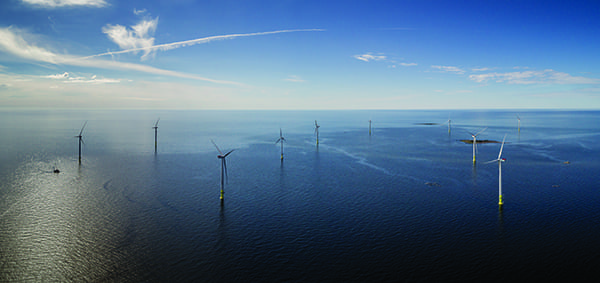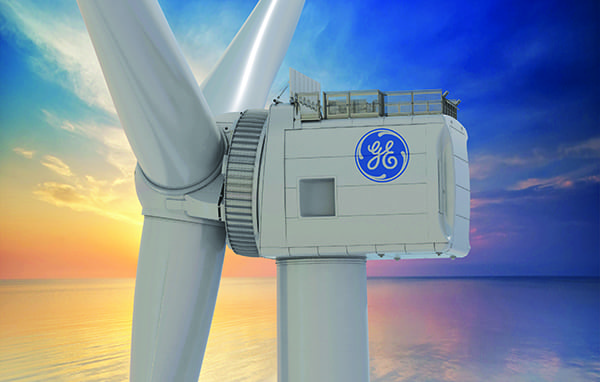A sharp surge in new, larger offshore wind installations in Europe throughout 2017 dramatically shows the viability of a technology that has truly come of age. As costs fall and generation capacity increases, subsidies and price support from the European Union and individual member states are now expiring, and the first self-standing offshore wind projects have been bid upon, signaling the beginning of a new phase.
Figures released in a February report by the Brussels-based WindEurope group, which bills itself as “the voice of the wind industry,” summarizes the increasing construction of European offshore wind farms. Throughout 2017, a record 3,148 MW of newly installed offshore capacity came online. This was twice as much as in 2016 and 4% higher than the previous record set in 2015.
Overall, 560 new offshore wind turbines were added across 17 wind farms. In total, as of the beginning of 2018, Europe had an installed offshore wind capacity of 15,780 MW generated by 4,149 grid-connected wind turbines operating within 92 separate offshore wind farms deployed by 11 countries.
Moreover, six additional offshore wind projects were announced in 2017 that are expected to come online in the coming years. These new investments total €7.5 billion and cover another 2.5 GW of capacity. WindEurope predicted that new investments in the offshore wind sector would top another €9 billion during 2018. When the report was released, 82 more turbines—equivalent to 1,927 MW—were awaiting grid connection. By 2020, WindEurope said offshore wind would grow to a total installed capacity of at least 25 GW, and that figure will likely rise steadily through 2030.
European Nations Increasingly Turn to Offshore Wind
Currently (and for the foreseeable future), the UK has the largest amount of installed offshore wind capacity in Europe, representing 43% of all installations. Germany follows with 34%. Denmark (8%), The Netherlands (7%), and Belgium (6%) round out the European top five. Combined, the group represents 98% of all grid-connected turbines in Europe.
Indeed, as the UK seems set to both leave coal and the European Union (EU) behind, it’s looking to offshore wind to play a huge part of its energy future. Of all the new offshore turbines erected, 53% of the net capacity brought online was in the UK, including the commissioning of a floating offshore wind farm, Hywind, in Scotland. By 2030, industry and government predictions call for more than 30 GW of offshore wind to be deployed by the UK alone.
Behind the UK, Germany installed the second-largest amount with 40% of total new European capacity, followed by Belgium with 5%. Finland witnessed the commissioning of the first offshore wind farm specifically designed for icy conditions, Pori Tahkoluoto 2 (Figure 1). More than 67% of all new net capacity installations were built in the North Sea, with 15% in the Irish Sea and 13% in the Baltic.
Significantly, France installed its first offshore wind turbine in 2017, a 2-MW unit. Very slow to get into the game while long depending on nuclear power, France has teamed up with General Electric, which has also been absent in the offshore arena, to make a major play here. Over the next five years, both are taking bold steps to move stridently into this sector as France’s construction is expected to ramp up dramatically. The new government has vowed to cut red tape while tendering a total of 3 GW of capacity. Based on announced projects, WindEurope predicts the country will eventually become the fourth-largest offshore wind generator with at least 4.3 GW of capacity coming online by 2030.
In fact, offshore wind energy costs have fallen so dramatically, simultaneous with improving technology, that even coal-heavy Poland has announced it will begin developing wind assets. Throughout March, several companies, including Norway’s Statoil, announced an expanding interest in partnering with Polish firms to construct at least 1.2 GW of offshore wind capacity in the Baltic. Without a doubt, both in Europe and worldwide, offshore wind is entering a more mature phase as turbines and facilities grow ever bigger and the technology becomes ever more dependable.
Jumbo Turbines and Wind Farms
The increased sizes and capacity ratings of the 560 new offshore wind turbines in Europe have increased the average size of installed wind turbines to 5.9 MW, a 23% increase over 2016, according to the WindEurope report. Simultaneously, the average size of the grid-connected European offshore wind farms is now 493 MW, 34% higher than the previous year. There has been a dramatic increase over the last decade; the average was only 79.6 MW in 2007.
A mammoth example is in progress off the east coast of England. Danish offshore wind company Ørsted, formerly DONG Energy, begun construction of the 1.2-GW Hornsea Project One wind farm in January 2018. Upon completion, it is expected to be the largest offshore wind farm in the world.
Ørsted recently announced that the first of 174 monopiles had been installed 120 kilometers off Yorkshire, each measuring 65 meters long and weighing approximately 800 metric tonnes. Eventually, each monopile will be topped with a Siemens-built 7-MW turbine. When complete in 2020, Hornsea Project One will generate enough electricity to provide for the equivalent of one million homes. And, as the name implies, this is only the first section of a planned 4-GW wind farm.
Another big development was announced by Mitsubishi Corp. It entered into an agreement to acquire a third of the shares of the Moray Offshore Windfarm (East) Ltd. (MOWEL). Beginning this year, MOWEL will start construction on another of the UK’s largest offshore wind farms, which is expected to produce more than 950 MW by 2022.
Siemens Gamesa Leads Market, but GE’s Haliade-X Could Pose Challenge
According to WindEurope, Siemens Gamesa Renewable Energy (SGRE) has far and away the most offshore wind turbines in operation—64% of the total. MHI Vestas Offshore Wind is the second-largest turbine supplier in Europe (18%), followed by Senvion (8%) and Adwen (6%). At the moment, SGRE is testing its new 8-MW unit with deployment scheduled later this year.
“The introduction of the SG 8.0-167 DD shows our continued dedication to industrializing the offshore market,” Andreas Nauen, CEO Offshore at SGRE, said in a press release launching the model. “With the rotor upgrade we offer our customers even higher energy yields at lower wind speeds. The flexibility of the offshore direct drive platform helps to reduce the Levelized Cost of Energy (LcoE) and at the same time mitigate risks,” he added. Similar to the upgrade from 7 MW to 8 MW, the technology on the direct drive platform allows for re-use of most components.
In early March, GE finally and dramatically announced that it too would enter the offshore turbine market. Following its merger with the French company Alstom, the combined firm is working closely with the government there to develop and deploy the Haliade-X (Figure 2), which GE is already billing as “the world’s most powerful offshore wind turbine.” Intended to have a maximum output of 12 MW, the Haliade-X may be able to generate 45% more energy than the largest turbines now available. GE will build them at new factories on the French Atlantic coast.
GE’s entry into offshore wind is part of the company’s restructuring following a steep decline in fossil fuel development worldwide. Jérôme Pécresse, president and CEO of GE Renewable Power, said the company could “get many positives out of the energy transition.” Reportedly, GE is investing about $400 million over the next three to five years to develop the Haliade-X and plans to complete the first turbine in 2019 with first shipments starting no later than 2021.
“The conventional wisdom, three, four years ago at GE was thermal power [will] keep growing and offshore wind is a fantasy,” Pécresse was quoted as saying in a Financial Times article. “Now offshore wind is not a fantasy, it’s a market. And GE can positively adapt and invest into it.”
Though GE has been very successful with onshore turbines since buying Enron’s wind division out of bankruptcy in 2002, becoming the fourth-largest onshore turbine manufacturer, it has been virtually absent offshore until now. Operators bidding for new subsidy-free offshore wind contracts have suggested larger turbines are needed for projects to be commercially viable. Pécresse said GE would provide welcome competition among suppliers, pushing the limits ever higher. “This turbine is the right size at the right time,” he said.
Subsidy-Free Wind Farms: Proof of a Maturing Industry
Just this year, the Netherlands awarded a contract to Vattenfall of Sweden for two 350-MW offshore wind farms hailed as the world’s first to be constructed without government subsidies. However, Germany last year also awarded two contracts for subsidy-free wind farms, but these won’t come online until after the Vattenfall projects.
The steep decline of offshore wind costs has been remarkable over the last decade. One estimate quoted by the Financial Times suggested the new subsidy-free German offshore projects may be able to generate power for about €31/MWh ($38/MWh). That’s markedly less than a U.S. Energy Information Administration forecast, which estimated an unsubsidized cost of $157/MWh. With falling costs, utilities are increasingly able to invest without relying on subsidies to ensure profitability.
Despite the large number of wind turbines coming online this year, WindEurope predicts that the continent will see another record amount connected to the grid in 2019. That said, the group predicts that beyond 2020, as EU states reach their mandated renewable energy goals, installations will slow, unless new decisions and targets are set.
Looking ahead to 2021 and 2022, based on available data, WindEurope expects at least another 3.1 GW and 3.2 GW to come online, respectively. Much of this will stem from the first French offshore projects that are likely to start dispatching electricity to the grid by 2021, as well as projects in Germany, Belgium, and the Netherlands. Overall, WindEurope expects a total capacity of 70 GW of offshore wind energy by 2030 in its “Central Scenario.” It predicts most will be in the North Sea (48 GW) with at least 9 GW installed in the Baltic by 2030 as well. ■
—Lee Buchsbaum (www.lmbphotography.com), a former editor and contributor to Coal Age, Mining, and EnergyBiz, has covered coal and other industrial subjects for nearly 20 years and is a seasoned industrial photographer.












